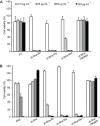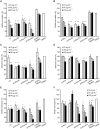Anti-biofilm Properties of Bacterial Di-Rhamnolipids and Their Semi-Synthetic Amide Derivatives
- PMID: 29276509
- PMCID: PMC5727045
- DOI: 10.3389/fmicb.2017.02454
Anti-biofilm Properties of Bacterial Di-Rhamnolipids and Their Semi-Synthetic Amide Derivatives
Abstract
A new strain, namely Lysinibacillus sp. BV152.1 was isolated from the rhizosphere of ground ivy (Glechoma hederacea L.) producing metabolites with potent ability to inhibit biofilm formation of an important human pathogens Pseudomonas aeruginosa PAO1, Staphylococcus aureus, and Serratia marcescens. Structural characterization revealed di-rhamnolipids mixture containing rhamnose (Rha)-Rha-C10-C10, Rha-Rha-C8-C10, and Rha-Rha-C10-C12 in the ratio 7:2:1 as the active principle. Purified di-rhamnolipids, as well as commercially available di-rhamnolipids (Rha-Rha-C10-C10, 93%) were used as the substrate for the chemical derivatization for the first time, yielding three semi-synthetic amide derivatives, benzyl-, piperidine-, and morpholine. A comparative study of the anti-biofilm, antibacterial and cytotoxic properties revealed that di-Rha from Lysinibacillus sp. BV152.1 were more potent in biofilm inhibition, both cell adhesion and biofilm maturation, than commercial di-rhamnolipids inhibiting 50% of P. aeruginosa PAO1 biofilm formation at 50 μg mL-1 and 75 μg mL-1, respectively. None of the di-rhamnolipids exhibited antimicrobial properties at concentrations of up to 500 μg mL-1. Amide derivatization improved inhibition of biofilm formation and dispersion activities of di-rhamnolipids from both sources, with morpholine derivative being the most active causing more than 80% biofilm inhibition at concentrations 100 μg mL-1. Semi-synthetic amide derivatives showed increased antibacterial activity against S. aureus, and also showed higher cytotoxicity. Therefore, described di-rhamnolipids are potent anti-biofilm agents and the described approach can be seen as viable approach in reaching new rhamnolipid based derivatives with tailored biological properties.
Keywords: amide derivative; biofilms; cell adhesion; di-rhamnolipids; rhamnolipids.
Figures








Similar articles
-
High mono-rhamnolipids production by a novel isolate Pseudomonas aeruginosa LP20 from oily sludge: characterization, optimization, and potential application.Lett Appl Microbiol. 2024 Feb 1;77(2):ovae016. doi: 10.1093/lambio/ovae016. Lett Appl Microbiol. 2024. PMID: 38366661
-
Rapid and solitary production of mono-rhamnolipid biosurfactant and biofilm inhibiting pyocyanin by a taxonomic outlier Pseudomonas aeruginosa strain CR1.J Biotechnol. 2020 Jan 10;307:98-106. doi: 10.1016/j.jbiotec.2019.11.004. Epub 2019 Nov 6. J Biotechnol. 2020. PMID: 31705932
-
Oxygen effects on rhamnolipids production by Pseudomonas aeruginosa.Microb Cell Fact. 2018 Mar 9;17(1):39. doi: 10.1186/s12934-018-0888-9. Microb Cell Fact. 2018. PMID: 29523151 Free PMC article.
-
Rhamnolipids: diversity of structures, microbial origins and roles.Appl Microbiol Biotechnol. 2010 May;86(5):1323-36. doi: 10.1007/s00253-010-2498-2. Epub 2010 Mar 25. Appl Microbiol Biotechnol. 2010. PMID: 20336292 Free PMC article. Review.
-
The involvement of rhamnolipids in microbial cell adhesion and biofilm development - an approach for control?Lett Appl Microbiol. 2014 May;58(5):447-53. doi: 10.1111/lam.12211. Epub 2014 Jan 24. Lett Appl Microbiol. 2014. PMID: 24372465 Review.
Cited by
-
Medical-Grade Silicone Coated with Rhamnolipid R89 Is Effective against Staphylococcus spp. Biofilms.Molecules. 2019 Oct 25;24(21):3843. doi: 10.3390/molecules24213843. Molecules. 2019. PMID: 31731408 Free PMC article.
-
Microbial Biosurfactants in Cosmetic and Personal Skincare Pharmaceutical Formulations.Pharmaceutics. 2020 Nov 16;12(11):1099. doi: 10.3390/pharmaceutics12111099. Pharmaceutics. 2020. PMID: 33207832 Free PMC article. Review.
-
Exploiting the Natural Diversity of RhlA Acyltransferases for the Synthesis of the Rhamnolipid Precursor 3-(3-Hydroxyalkanoyloxy)Alkanoic Acid.Appl Environ Microbiol. 2020 Mar 2;86(6):e02317-19. doi: 10.1128/AEM.02317-19. Print 2020 Mar 2. Appl Environ Microbiol. 2020. PMID: 31924623 Free PMC article.
-
Tuning Anti-Biofilm Activity of Manganese(II) Complexes: Linking Biological Effectiveness of Heteroaromatic Complexes of Alcohol, Aldehyde, Ketone, and Carboxylic Acid with Structural Effects and Redox Activity.Int J Mol Sci. 2021 May 3;22(9):4847. doi: 10.3390/ijms22094847. Int J Mol Sci. 2021. PMID: 34063691 Free PMC article.
-
Novel Treatment Strategies for Biofilm-Based Infections.Drugs. 2019 Oct;79(15):1635-1655. doi: 10.1007/s40265-019-01184-z. Drugs. 2019. PMID: 31468316 Review.
References
LinkOut - more resources
Full Text Sources
Other Literature Sources
Molecular Biology Databases

